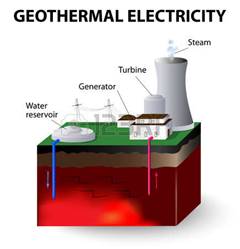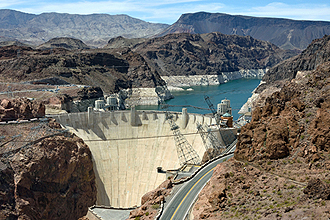| University of Colorado at Boulder | ||||||
 |
||||||
|
Instances of induced seismicity have been documented in the United States and throughout the world. Non-oil and gas related causes of human-induced earthquakes include operation of enhanced geothermal systems and CO2 sequestration. Both of these processes have similarities to oil and gas related inducement because they involve injection of fluids or gases. Dam building, including the subsequent reservoirs created by large dams, and mining activities are also known to induce earthquakes. Geothermal Systems
Enhanced geothermal systems have injection wells and production wells. Fracturing existing stress fractures is often used to transmit water from the injection wells to the production wells; the water is heated by the rock formation between injection and production, which can then be used for energy production. Induced seismicity can result from the fracturing of the stress fractures in the EGS process. These events have, to date, been relatively small in magnitude and a majority have not been felt and have not caused significant danger or significant damage to structures. Induced Seismicity has been documented in a number of operating geothermal fields and EGS projects with most resulting from the EGS projects.. In the most prominent cases, thousands of earthquakes are induced annually. These are predominantly micro earthquakes that are not felt by people, but also include earthquakes of magnitudes up to the mid-magnitude 4s. Several different mechanisms have been hypothesized to explain these occurrences of induced seismicity in geothermal settings such as: pore-pressure increase, temperature changes, volume change due to fluid withdrawal/injection, and chemical alteration of fracture surfaces. Pohang, South Korea experienced the largest earthquake ever to be triggered by enhanced geothermal power on November 15th, 2017. With a 5.5 magnitude, several kilometers away from the geothermal plant, South Korea is now experiencing a “wake-up call” after using high-pressure water injection into the subsurface to create the heating reservoir. Right below the 4-kilometer deep well, “the high-pressure water lubricated an unknown fault in the rock, causing it to slip and trigger the earthquake,” says seismologist Kwamghee Kim. Paul Voosen explains in his American Association from the Advancemet of Science article: unlike the recent spikes of induced earthquakes in Oklahoma due to hydraulic fracturing and oil and gas production, “water from enhanced geothermal power does not stay underground or cause a long-term buildup of pressure." In addition, Pohang implemented a new “soft stimulation” strategy to reduce earthquake size just a few months before the 5.5 magnitude earthquake. The technique allows water under pressure to be injected in limited and gentle ways, which has inconclusive effects considering the incident. The Environmental Protection Agency (EPA) regulates geothermal systems as Class V wells, which are wells that are used to inject non-hazardous fluids, as well as any wells that are not classified in Classes I, II, III, IV, or VI. Class V wells are regulated through the Underground Injection Control (UIC) program under the Safe Drinking Water Act, and must meet minimum requirements to prevent contamination of underground sources of drinking water. CO2 SequestrationGeological carbon sequestration, also known as carbon capture and storage, geosequestration, and carbon sequestration, is a method by which carbon dioxide is captured from stationary sources (such as power stations and industrial plant smokestacks) and stored underground in rock formations and aquifers. The injection of carbon dioxide into reservoirs can increase pore pressure and, if the reservoir is near a potentially active fault, can decrease the frictional resistance to fault slip, releasing stored energy and resulting in earthquakes. Operators choosing CO2 sequestration sites should avoid larger faults that could result in larger earthquakes, but smaller faults that are associated with small-to-moderate earthquakes can be more difficult to recognize (can be undetected or undetected faults). In the case of CO2 sequestration, even small earthquakes could rupture the sealing of the CO2 reservoir, allowing the stored CO2 to escape. EPA regulates injection of CO2 for sequestration as Class VI UIC wells. DAMS AND RESERVOIRS Mining – Solution and ExtractionMining activities can cause a rock burst, which is “a violent expulsion of rock form the walls of a mine opening caused by heavy pressure on brittle rocks in deep mines where mining has deprived the rock of support on one side.” (Merriam-Webster) Most rock bursts – the most common cause of induced seismicity in relation to mining activity – occur in coalmines. Induced seismicity in mining activities depends on a variety of factors, including production rate, fault location, and the location and depth of the mining activity. Most seismic events are less than magnitude zero on the Richter scale for mines, however, and often are produced after production blasting. (Mining Induced Seismicity, S.K. Guha) While the seismic events are not large, the events can cause other issues, such as damage to mines and mining equipment and, in some cases, a loss of life. While many mines are likely associated with some seismic activity, precise numbers regarding frequency or severity of seismic activity resulting specifically from mining activity are uncommon. Tremors from mining-related activities such as a collapse of an underground cavity, blasting of material during mining operations, and tremors as a result of movement along a fault or due to uplifting can be difficult to distinguish when felt, and many seismologists distinguish seismicity as a distinctive product compared to mine collapses and blasting activities. (Cypser, 1997) Additional ResourcesGeothermal
CO2 Sequestration
Reservoirs
|
||||||

 Geothermal systems use heat from steam produced in hot water reservoirs beneath the Earth’s surface to power turbines and generate energy. An Enhanced Geothermal System (EGS) is an engineered subsurface heat exchanger designed to either extract geothermal energy under circumstances in which conventional geothermal production is uneconomic. The Department of Energy (
Geothermal systems use heat from steam produced in hot water reservoirs beneath the Earth’s surface to power turbines and generate energy. An Enhanced Geothermal System (EGS) is an engineered subsurface heat exchanger designed to either extract geothermal energy under circumstances in which conventional geothermal production is uneconomic. The Department of Energy ( Reservoir-Induced Seismicity (RIS) is a phenomenon that occurs when a reservoir triggers seismic activity due to the water of the reservoir increasing pore pressure in rock formations near a dormant fault. RIS was first observed in 1932 at the Qued Fodda Dam in Algeria. Small earthquakes rocked the area around Qued Fodda Dam, despite the area not having been previously seismically active. Many small earthquakes occurred around Lake Mead after Hoover Dam was built, with over 400 small earthquakes in a period soon after the lake was full. More earthquakes have been noted since; the induced seismicity correlates with water levels in the reservoir. The Oroville dam, which impounded water to create Lake Oroville in California also resulted in earthquakes, one of which reached magnitude 5.7 in 1975. (
Reservoir-Induced Seismicity (RIS) is a phenomenon that occurs when a reservoir triggers seismic activity due to the water of the reservoir increasing pore pressure in rock formations near a dormant fault. RIS was first observed in 1932 at the Qued Fodda Dam in Algeria. Small earthquakes rocked the area around Qued Fodda Dam, despite the area not having been previously seismically active. Many small earthquakes occurred around Lake Mead after Hoover Dam was built, with over 400 small earthquakes in a period soon after the lake was full. More earthquakes have been noted since; the induced seismicity correlates with water levels in the reservoir. The Oroville dam, which impounded water to create Lake Oroville in California also resulted in earthquakes, one of which reached magnitude 5.7 in 1975. ( Seismic Damage
Seismic Damage